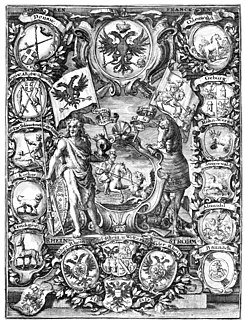
The Diocese of Passau is a Roman Catholic diocese in Germany that is a suffragan of the Archdiocese of Munich and Freising. It should not be confused with the Prince-Bishopric of Passau, an ecclesiastical principality that existed for centuries until it was secularized in 1803. The diocese covers an area of 5,442 km².

The Prince-Bishopric of Würzburg was an ecclesiastical principality of the Holy Roman Empire located in Lower Franconia west of the Prince-Bishopric of Bamberg. Würzburg had been a diocese since 743. As definitely established by the Concordat of 1448, bishops in Germany were chosen by the canons of the cathedral chapter and their election was later confirmed by the pope. Following a common practice in Germany, the prince-bishops of Würzburg were frequently elected to other ecclesiastical principalities as well. The last few prince-bishops resided at the Würzburg Residence, which is one of the grandest baroque palaces in Europe.

The Schönborn family is a noble and mediatised formerly sovereign family of the former Holy Roman Empire.

Johann Philipp von Schönborn was the Archbishop-Elector of Mainz (1647–1673), the Bishop of Würzburg (1642–1673), and the Bishop of Worms (1663–1673).

Friedrich Karl von Schönborn was the Prince-Bishop of Würzburg and Prince-Bishop of Bamberg from 1729 to 1746. He also served as Reichsvizekanzler (Vice-Chancellor) of the Holy Roman Empire from 1705 to 1734.
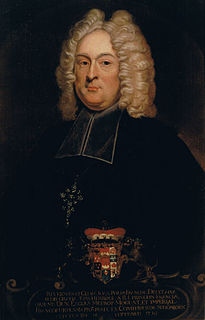
Johann Philipp Franz von Schönborn (1673–1724) was the Prince-Bishop of Würzburg from 1719 to 1724. His principal claim to fame is his commissioning of the Würzburg Residence, a major work of Baroque architecture.

Johann Gottfried von Aschhausen (1575–1622) was the Prince-Bishop of Bamberg from 1609 to 1622 and Prince-Bishop of Würzburg from 1617 to 1622.

Franz von Hatzfeld was the Prince-Bishop of Würzburg from 1631 to 1642 and the Prince-Bishop of Bamberg from 1633 to 1642.
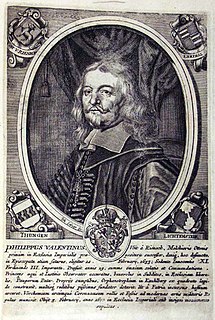
Philipp Valentin Albrecht Voit von Rieneck (1612–1672) was the Prince-Bishop of Bamberg from 1653 to 1672.

Peter Philipp von Dernbach (1619–1683) was the Prince-Bishop of Bamberg from 1672 to 1683 and Prince-Bishop of Würzburg from 1675 to 1683.
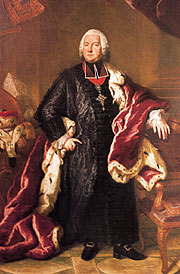
Adam Friedrich Graf von Seinsheim (1708–1779) was the Prince-Bishop of Würzburg from 1755 to 1779 and Prince-Bishop of Bamberg from 1757 to 1779.

Melchior Zobel von Giebelstadt (1502–1558) was the Prince-Bishop of Würzburg from 1544 to 1558.
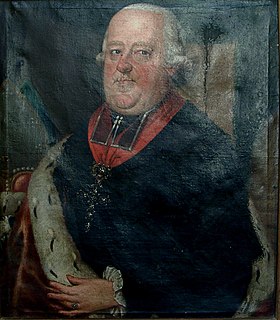
Georg Karl Ignaz Freiherr von Fechenbach zu Laudenbach (1749–1808) was the last Prince-Bishop of Würzburg, holding office from 1795 until 1803, when the Prince-Bishopric of Würzburg was mediatised to the Electorate of Bavaria. He continued to serve as Bishop of Würzburg, though without temporal power, until his death. He was also Bishop of Bamberg from 1805 until his death.

Balthasar von Dernbach, was a Benedictine monk of Fulda monastery and its Prince-Abbot from 1570 to 1606.
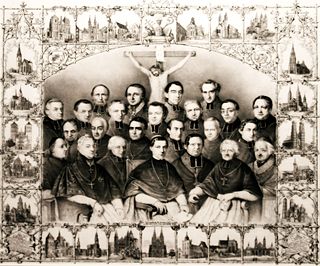
The Würzburg Bishops' Conference of 1848 was a four-week workshop of the German Catholic bishops in Würzburg. It can be regarded as the birth of the German and Austrian bishops' conferences.
Georg Arnold was an Austrian composer and organist.
Georg Mengel was a German composer. After service in the army from 1640 he was Kapellmeister to Fürstbischof Melchior Otto Voit von Salzburg at the court of the Prince-Bishopric of Bamberg.

Gößweinstein Castle, also called Schloss Gößweinstein, is a mediaeval hilltop castle in Gößweinstein in the county of Forchheim in the German state of Bavaria. It towers high above the market town and the River Wiesent and may have been the inspiration for Richard Wagner's grail castle in his opera, Parsifal. The castle is a Bavarian listed building, no. D-4-74-129-10.


